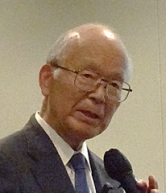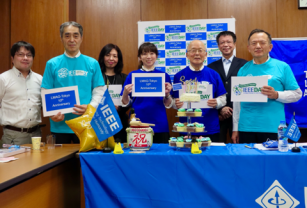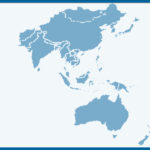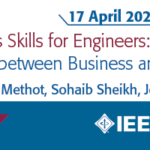Tokyo Section

Tadashi Takano received B.S., M.Sc., and Ph.D. degrees in Electrical and Electronic Engineering from the University of Tokyo in 1967, 1969, and 1972, respectively. In his M.Sc. thesis, he researched a microwave resonator using superconductivity, and verified quite a high Q and several non-linearities. In his Ph.D. thesis, he changed the research topic to an integrated optical modulator as the next generation of communications was expected to be based on optical techniques. He found quite different characteristics of wave prorogation in an integrated optical waveguide by experiment and analyzed the dependency on materials and size. The phenomenon was later known as a plasmon.
In 1972, he joined the Electrical Communication Laboratories (ECL) of Nippon Telegraph and Telephone Public Corporation (currently NTT). He wanted to contribute to social benefit through actual telecommunication systems, so he selected the Transmission System Development Division instead of the Research Division in ECL. He was surprised that he was assigned to the Antenna Section and was requested to clarify the characteristic degradation of antennas that had been already installed in a microwave repeating system. As he had no experience in antenna engineering, he measured all the antennas by his method. Finally, he verified the cause of the degradation by experiment and later by analysis. At this point, he was sent to the Research Center of the German Federal Post in Germany to study antennas and met related researchers from 1975 to 1976. Returning to Japan, he was assigned to the NTT Research and Development Bureau, which manages the R&D planning, financial budget, and human affairs of ECL. After that, he studied NTT’s high-speed communication network.
In 1984, he moved to the Institute of Space and Astronautical Science (ISAS) in Japan, where he was a Professor of Radio Tracking. He engaged in the operation and research work related to Japan’s largest antenna, 64 meters in diameter. This work included the collaborative radio science experiment on Neptune’s atmosphere with NASA using the deep space explorer Voyager 2 and the world’s first VLBI experiment using a satellite in orbit. He was also the system manager of a solar exploration satellite and manager of the extendable antenna subsystem carried by the world’s first VLBI satellite. Meanwhile, he continued basic research on antennas while educating students. From 1987 to 1988, he was sent by the Ministry of Education to NASA’s Jet Propulsion Laboratory in the USA.
As he had a solid intention to utilize space activities for human benefit, with two collaborators, he founded the Society of Space Missions within the Japan Society for Astronautical and Space Science, which is the world’s first society specializing in mission investigations rather than in the methods or results of space research. He was invited to join the Society of Solar Power Satellite Research that Prof. Nagatomo of ISAS had led. He contributed to it based on antenna technology to become the Representative Manager. In 2009, he founded a non-profit corporation, the Society for Space Travel of Japan, with a businessman who founded a travel agency and an economist covering this special technology field.
In 1991, he became a Professor in Electronic Engineering at the Graduate School of the University of Tokyo and gave lectures on space communications and antenna engineering. In 2008, he retired from the University of Tokyo and ISAS and was awarded Emeritus Professorship. In the same year, he moved to Nihon University as Professor. He is now a Fellow Researcher at the same university. As described above, he changed research topics several times, extending his work from basic research to social applications. He enjoyed this but now thinks it might have been better to focus on a more limited range of topics to obtain tremendous success. As for executive activities, from 1996 to 1997, Prof. Takano served as Chair of the Measurement Group of IADC, which aims to analyze and mitigate space debris in orbit. From 1997 to 2000, he was General Chair of the International Symposium on Antennas & Propagation (ISAP) 2000, where he established a collaborative framework with the corresponding institutions of IEEE AP-S in the USA and AP2000 in Europe. It was a great success commemorating the millennium year 2000. At the same time, he promoted the global relocation of ISAP venues by holding the first Japan-original conference in a foreign country. Later, ISAP was held annually in countries in the Asia-Pacific region. From 1996 to 2020, he served on the executive committee of IEEE LMAG-Tokyo, and in 2020 had the opportunity to arrange the 10th Anniversary of the LMAG-Tokyo foundation as the LMAG-Tokyo Chair, for which LMAG-Tokyo was later awarded the 2021 IEEE Life Members Affinity Group Achievement Award. He was awarded a Life Member Shirt Award by IEEE R10.
He served as Chair and member of many governmental and public organizations. Also, he served as Chair and committee member of many academic conferences and meetings. He was the editor of journals of the Institute of Electronics, Information and Communication Engineers (IEICE) of Japan and the Japan Society for Aeronautical and Space Science. He is currently the chief editor of the Space Engineering Series published by Corona Publishing Co., Ltd.
He has had 14 books published, some of which were co-authored, 122 journal papers, 247 papers in foreign conferences, 370 papers in domestic conferences, and many lectures and explanatory materials. He received the 1975 Yonezawa Award and the 1992 Excellent Paper Award, both from IEICE, the 1983 President Award and Kajii Award from NTT, the 1998 Prize of the Japan Society for the Promotion of Machine Industry, and the iWAT2010 Best Paper Prize. Prof. Takano is a member of IEEE (Fellow), IEICE (Fellow), Institute of Electrical Engineers of Japan, URSI, Japan Society for Aeronautical and Space Science, Japan Rocket Society, Space Solar Power Research Society (Director), Society for the Space Travel of Japan (Chairman of the Board), and Japan Space Elevator Association (Adviser).



